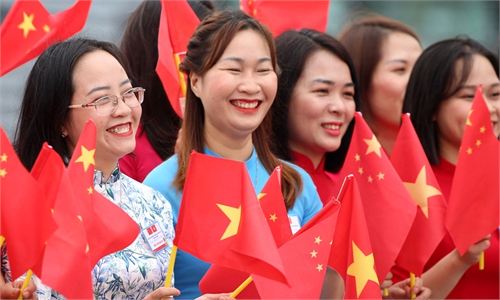IN-DEPTH / IN-DEPTH
A growing number of Latin American people views China in a mix of recognition and expectations

View of a coast in Lima, Peru Photo: VCG
Throughout the course of 2023, leaders from many Latin American countries have visited China, highlighting the importance attached to cooperation between China and Latin America. In line with frequent high-level interactions, there has been a continuous deepening of people-to-people exchanges between China and Latin America. Although the vast Pacific Ocean is a massive physical barrier between China and Latin America, the long-standing interactions have laid a solid foundation for the enduring friendship between the two regions. The 16th China-LAC Business Summit was held in Beijing in November, and the China-Latin America Think Tank Cooperation Dialogue was also held simultaneously as an important part of the summit. From December 11 to 13, the first China-LAC Military Medicine Forum will be held in Beijing.
Relevant polls and interviews with locals conducted by Global Times reporters indicate that people in Latin America particularly appreciate China's economic and technological development, and look forward to deepening cooperation and sharing development with China. A young Argentine woman who has studied Chinese for 6 years and previously worked for a Chinese company, said, "I believe the future is in China!"
Wish to join China's development
The Pew Research Center released a survey report in July covering 24 countries' views on China, including Brazil, Mexico, and Argentina in Latin America. Its statistics showed that in these countries, over 30 percent of the respondents view China as a global economic leader, and nearly half of them believe that China's economic development is a good thing.
Elias, a Chinese immigrant residing in Argentina for 13 years, shared with the Global Times, "Economic challenges have persistently troubled Argentina, and many locals feel that China's economic growth is rapid. Witnessing the skyscrapers and high-tech products in China online, numerous Argentinians aspire to learn Chinese, aiming to secure job opportunities. This interest is particularly pronounced among Argentinian businessmen and farmers who are eager to explore whether China's economic development can help their own success."
The economic relationship between China and Latin America is highly complementary. According to data from the Chinese Ministry of Commerce, China has consistently been Latin America's second-largest trading partner since 2012.
In 2022, the trade volume between China and Latin America edged on $500 billion, maintaining high-speed growth for six consecutive years. Currently, China has signed free trade agreements with five Latin American countries, including Chile, Peru, Costa Rica, Ecuador, and Nicaragua.
Due to its high cost-effectiveness and technological advantages in new energy vehicles (NEVs), China's automotive industry has gained favor among Latin Americans. China has ascended to become Brazil's second-largest source of automobile imports, with Chinese automakers like Chery, JAC, and Geely steadily establishing a presence in the Brazilian market over the past decade. Emerging players such as Great Wall Motors and BYD are also making notable strides.
As a natural extension of the 21st Century Maritime Silk Road, Latin America has become an important participant in the joint construction of the Belt and Road Initiative (BRI). So far, 22 Latin American and Caribbean countries have signed cooperation agreements with China on the BRI, deepening and strengthening cooperation in various fields between China and Latin America.
In Peru, many have pinned high hopes on the Chancay Port project, which is currently under construction by a Chinese company. The Chancay Port is located about 80 kilometers from the capital Lima, and the first phase of the project is expected to be completed in November 2024, according to media reports. The Global Times learned that the project will open up a new key route between Asia and South America. It will strengthen Peru's position as a regional transportation hub and provide a permanent investment attraction and create employment opportunities in the future.
Besides, projects invested in and constructed by Chinese companies are also helping improve quality of life and solve quotidian challenges for people in Latin America. Due to low precipitation and high salinity in the groundwater, the indigenous community in Joao Camara, Rio Grande do Norte in Brazil, regularly faced drinking water shortages. In February, a public welfare project for desalination of brackish water, invested in and constructed by a Chinese company was officially inaugurated. Using China's own products and advanced technology, the project can provide more than 75 metric tons of pure drinking water a day, which meets international sanitary standards, benefiting more than 3,000 locals, and has won much praise.
The joint 40-meter radio telescope project between China and Argentina has now been installed and launched, which is of great significance for the cooperation, research, and talent exchange and cultivation between the two countries in this field. A professor from the National University of San Juan in Argentina told the Global Times, "We sincerely thank China for coming here to build the telescope. If we were to rely solely on our own project funding, we wouldn't even be able to maintain the basic operation of the observatory."
In recent years, more Chinese companies have entered the Latin American market, stimulating the vitality of industries such as infrastructure and transportation in these countries, and creating a large number of job opportunities. Many Latin Americans now see learning Chinese as a key to opening up career paths. Celeste used to work for a branch of Huawei in Argentina. After studying Chinese for six years, she won an award in the Chinese Bridge competition and received a scholarship to study at Jilin University. She told the Global Times excitedly that she believes that "the future is in China!"
Challenges in telling China stories
Thanks to centuries of Chinese migration to the Latin American region, the legacy of China is not entirely unfamiliar to many in the area. Folk exchanges between China and Peru can be traced back over 400 years to the Galeón de Manila, when overseas Chinese first settled in Peru. In November, CHIFA UNION, a Chinese restaurant in Lima, marked its centenary. This Chinese restaurant brand is ubiquitous across Peru, and nearly every Peruvian can name a few popular Chinese dishes.
Beyond Chinese cuisine, overseas Chinese have brought the tradition of celebrating the Spring Festival to Latin America. Various cities in Brazil have officially designated the Spring Festival as a holiday. The Spring Festival temple fair in Argentina has gained recognition as a well-known cultural brand in the local area, attracting over 200,000 participants from Argentina in 2023. Peruvian media outlets frequently publish articles analyzing zodiac culture and annual fortune at the end of each year.
At the same time, the prosperous development of modern Chinese culture allows Latin American people to have a more comprehensive understanding of China. Short videos, for example, have become an important channel for Latin American people to learn about China. The "China-Latin America, Neighbors Across the Ocean" short video competition was held from May to August 2023, and 11 winners from 9 Latin American countries were invited to China to participate in exchange and training programs. Mao Dou (screen name), a Mexican musician and short video creator, was one of the winners. He told the Global Times that his childhood dream was to visit China and that he has harbored a long-time desire to live in the country of his dreams.
At the largest Lima International Book Fair in Peru in August this year, books on China's poverty alleviation, Chinese children's books, and China's economy attracted particular attention from Peruvian readers.
However, there are still challenges in sharing and spreading the Chinese story in Latin America. Global Times reporters stationed in Latin American countries have found that local people still hold many stereotypes and misunderstandings about China. Ding Ding, a Chinese student studying in Mexico, told the Global Times that the internet is filled with complex information, some biased or malicious. For instance, TikTok videos featuring Japanese cuisine sometimes have misleading titles like "authentic Chinese food," and many Mexicans believe it without question. Ding stated, "Some Mexicans even bring up fake news they saw on television years ago and ask me if Chinese rice is made of plastic."
According to the Global Times correspondent in Brazil, mainstream media in the largest country in South America generally lacks correspondents stationed in China. When reporting on Chinese news, they often rely on quotes from Western media sources, which makes objective reporting virtually impossible. Some Brazilians even believe that "China is a traditional and conservative Buddhist country." Jiang Shixue, director of the Center for Latin American Studies of Shanghai University, told the Global Times that currently, the biggest challenge is that China's voice may not necessarily reach Latin America. Compared to Western media, the influence and coverage of Chinese media in Latin America is still insufficient.
Strengthen people-to-people exchanges
The Global Times has found that many Latin Americans are concerned about the low cost of Chinese products, and believe that their government needs to introduce policies to protect domestic enterprises.
Liu Xuedong, a professor of economics at the National Autonomous University of Mexico, said that Chinese imports had indeed affected local processing industries and employment opportunities in the past, leading to some negative views of China among the local population. However, he emphasized that with more cooperation projects under the Belt and Road Initiative (BRI) and Chinese companies entering Latin America, making positive contributions to the region's development, the impression of China among local people is continually improving.
Surveys conducted by Western polling agencies also indicate that the perception of China by some Latin Americans is, to some extent, influenced by the West. For instance, Pew Research shows that the proportion of people in Latin America with positive views on China is relatively close to those with negative views. While many Latin Americans recognize China's technological achievements and its image as an economic and political power, some who are distant from China express concerns about China's so-called "military diplomacy."
In response, experts believe that as China-Latin America cooperation increases and people-to-people exchanges strengthen, the perception of China among those with negative views will also change.
The perception of China by the people of traditional Latin American powers such as Brazil, Argentina, and Mexico is complex and can also be influenced by the ruling party, said Jin Xiaowen, a researcher at the School of International Studies, Renmin University of China. And whether or not they have actually been to China has a significant impact on the "China view" of Latin Americans, Jin added, noting that Chinese companies are an important force in promoting people-to-people exchanges between China and Latin American countries.

